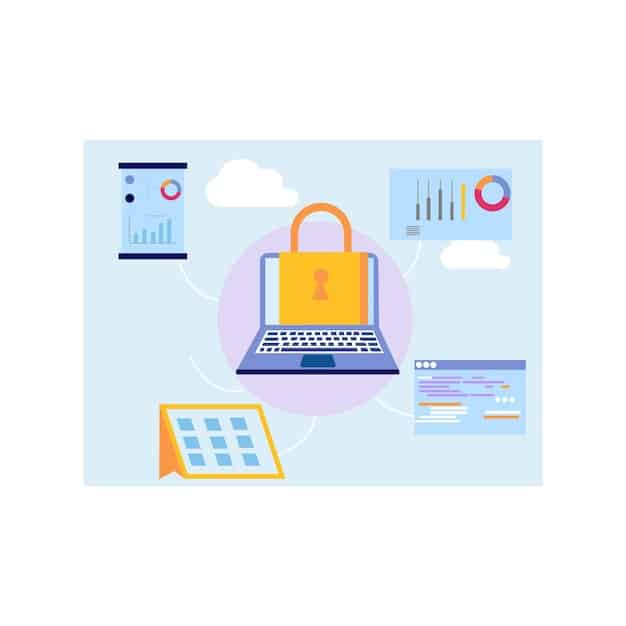New Federal Regulations: Protecting Student Data Privacy Online

New federal regulations on student data privacy aim to protect children’s information online by establishing stricter guidelines for data collection, usage, and disclosure by educational institutions and third-party service providers.
In today’s digital age, the privacy of student data is more critical than ever. The implementation of new federal regulations on student data privacy: protecting children’s information online, marks a significant step forward in safeguarding sensitive information and ensuring a safer online learning environment for students across the United States.
Understanding the Need for Updated Regulations
The digital landscape has transformed the way students learn and interact with educational resources. This shift brings immense opportunities but also introduces significant risks concerning student data privacy. Understanding the reasons behind the updated regulations is crucial for educators, parents, and students alike.
The Increasing Threat to Student Data
With the proliferation of online learning platforms and educational apps, the amount of student data being collected and stored has grown exponentially. This data includes not only academic records but also personal information, browsing history, and even biometric data. The more data that is available, the greater the risk of data breaches, identity theft, and misuse of personal information.
Loopholes in Existing Laws
Existing federal laws, such as the Family Educational Rights and Privacy Act (FERPA), provide some level of protection for student data. However, these laws were written before the rise of the internet and do not adequately address the challenges posed by modern technology. Loopholes in these laws have allowed third-party companies and educational institutions to collect and use student data in ways that were not originally intended, often without the explicit consent of parents or students.
- FERPA’s limitations in addressing third-party data sharing.
- The need for clearer guidelines on data collection and usage.
- The necessity of parental consent for data sharing with external entities.
Therefore, the new regulations aim to close these loopholes and provide a more comprehensive framework for protecting student data in the digital age. By strengthening existing laws and addressing emerging threats, these regulations seek to ensure that students can benefit from technology without compromising their privacy.

Key Components of the New Federal Regulations
The new federal regulations on student data privacy are designed to provide comprehensive protection for children’s information online. These regulations address various aspects of data collection, usage, and disclosure, ensuring that schools and third-party vendors adhere to strict standards. Let’s delve into the key components of these groundbreaking rules.
Enhanced Consent Requirements
One of the most significant changes is the enhanced consent requirements for collecting and sharing student data. Under the new regulations, schools must obtain explicit consent from parents or legal guardians before sharing student data with third-party vendors.
Data Minimization Principles
The regulations also incorporate data minimization principles, which means that schools and vendors should only collect the data that is absolutely necessary for the intended purpose. This principle aims to reduce the amount of sensitive information being stored, thereby minimizing the risk of data breaches and misuse.
- Limiting data collection to essential information only.
- Regular audits of data storage practices.
- Secure deletion of data when it is no longer needed.
Furthermore, the regulations mandate that schools provide transparent information about their data collection and usage practices. This includes clearly outlining the types of data being collected, the purposes for which it is being used, and the measures being taken to protect its security. By empowering parents and students with this information, the regulations promote greater accountability and transparency in the handling of student data.
How the Regulations Impact Schools and Educators
The introduction of new federal regulations on student data privacy brings about significant changes for schools and educators. These changes require a comprehensive understanding of the new requirements and a commitment to implementing best practices for data protection. This section explores the primary ways in which schools and educators will be affected.
Updating Data Privacy Policies
Schools will need to update their data privacy policies to align with the new regulations. This includes clearly defining the types of data collected, the purposes for which it is used, and the measures taken to protect its security.
Training for Staff and Teachers
Educators will need to be trained on the new regulations and their responsibilities for protecting student data. This training should cover topics such as data minimization, consent requirements, and data breach response protocols.
- Workshops on data privacy best practices.
- Regular updates on regulatory changes.
- Resources for addressing student data privacy concerns.
Moreover, schools will need to establish clear processes for obtaining parental consent for data collection and sharing. This includes providing parents with easy-to-understand information about the types of data being collected, the purposes for which it is being used, and the measures being taken to protect its security. By prioritizing data privacy, schools can build trust with parents and create a safer learning environment for students.
What Parents Need to Know About Student Data Privacy
As new federal regulations on student data privacy come into effect, it’s crucial for parents to understand their rights and responsibilities in safeguarding their children’s information online. These regulations offer enhanced protections, but parents must actively engage to ensure their children’s data is secure.
Understanding Your Rights
Under the new regulations, parents have the right to access, review, and request corrections to their children’s educational records. This includes the right to know what types of data are being collected, how it is being used, and with whom it is being shared.
Engaging with Schools
Parents should actively engage with their children’s schools to understand their data privacy policies and practices. This includes attending school board meetings, reviewing data privacy policies, and asking questions about data collection and usage.

- Talk to your children about online safety and data privacy.
- Review the privacy settings on educational apps and websites.
- Report any suspected data breaches or privacy violations to the school and relevant authorities.
Parents should also take steps to protect their children’s data at home by monitoring their online activity, using strong passwords, and keeping software up to date. By working together, parents and schools can create a culture of data privacy that protects students’ information and promotes a safer online learning environment.
The Role of Technology Vendors in Data Protection
Technology vendors play a pivotal role in upholding new federal regulations on student data privacy. These vendors, providing educational apps and platforms, must adhere to strict data protection standards. Their compliance is vital in ensuring the safety and security of student information.
Vendor Agreements and Compliance
Schools must ensure that their agreements with technology vendors include clear provisions for data privacy and security. These agreements should outline the vendor’s responsibilities for protecting student data, as well as the consequences for non-compliance.
Data Security Measures
Vendors are required to implement robust data security measures to protect student information from unauthorized access, use, or disclosure. This includes using encryption, firewalls, and other security technologies to safeguard data.
Moreover, technology vendors should be transparent about their data collection and usage practices. This includes providing clear and easy-to-understand privacy policies that outline the types of data being collected, the purposes for which it is being used, and the measures being taken to protect its security.
Enforcement and Accountability Mechanisms
The effectiveness of new federal regulations on student data privacy hinges on robust enforcement and accountability mechanisms. These mechanisms ensure that schools, educators, and technology vendors adhere to the new standards, thereby protecting students’ data.
Federal Oversight
Federal agencies will play a key role in overseeing the implementation and enforcement of the new regulations. This includes conducting audits, investigating complaints, and imposing penalties for violations.
State and Local Enforcement
State and local education agencies will also have a role in enforcing the new regulations. This includes developing and implementing data privacy policies, providing training and support to schools and educators, and investigating complaints.
- Providing clear guidelines for reporting data breaches.
- Establishing a process for resolving data privacy disputes.
- Holding schools and vendors accountable for violating data privacy laws.
Importantly, victims of data breaches and privacy violations must have the right to seek legal remedies. This includes the ability to file lawsuits, seek damages, and obtain injunctive relief to prevent further harm. By empowering individuals to assert their rights, the regulations promote greater accountability and transparency in the handling of student data.
| Key Point | Brief Description |
|---|---|
| 🛡️ Enhanced Consent | Explicit parental consent required for sharing student data with third parties. |
| 🔒 Data Minimization | Collecting only necessary data to reduce security risks. |
| 🧑🏫 Staff Training | Educators trained on data privacy and protection protocols. |
| 🏛️ Federal Oversight | Federal agencies to oversee enforcement and compliance. |
Frequently Asked Questions (FAQ)
▼
The new regulations enhance consent requirements, enforce data minimization principles, and mandate transparent data practices. They also increase data security measures and provide federal oversight to ensure compliance.
▼
Schools must update their data privacy policies, train staff on data protection, and establish clear processes for obtaining parental consent. They must also ensure vendor agreements comply with the new standards.
▼
Parents have the right to access, review, and request corrections to their children’s educational records. They can also know what data is collected, how it’s used, and whom it’s shared with.
▼
Technology vendors must adhere to strict data protection standards. They are required to implement data security measures and be transparent about data collection and usage practices. Schools must ensure their agreements comply.
▼
Federal agencies will oversee implementation, conduct audits, investigate complaints, and impose penalties. State and local agencies will also enforce policies, provide training, and resolve disputes to ensure accountability.
Conclusion
Implementing the new federal regulations on student data privacy: protecting children’s information online represents a crucial step forward in ensuring a safe and secure digital learning environment. By understanding and adhering to these regulations, stakeholders can help to safeguard student data and promote a culture of data privacy in education. As we move deeper into the digital age, the commitment to protecting children’s privacy must remain a top priority for local communities across the US.





